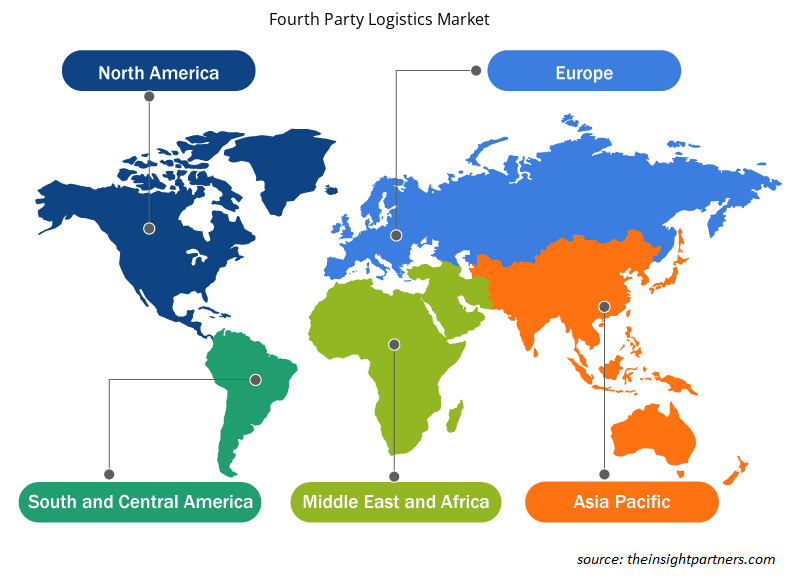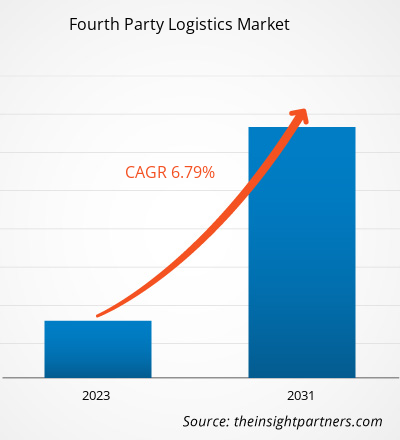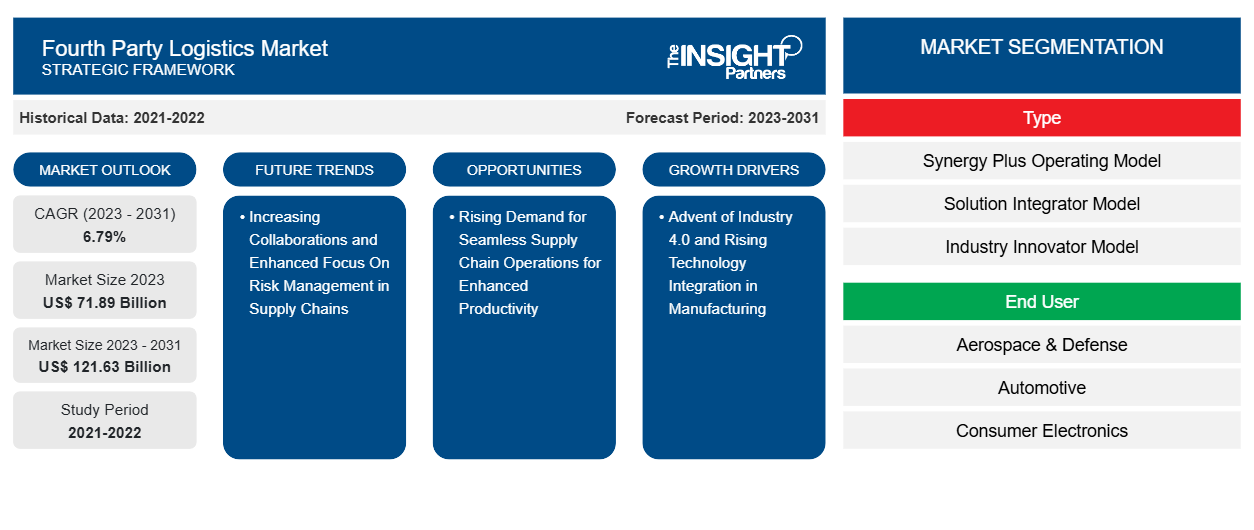Si prevede che la dimensione del mercato della logistica di quarta parte raggiungerà i 121,63 miliardi di dollari entro il 2031, rispetto ai 71,89 miliardi di dollari del 2023. Si prevede che il mercato registrerà un CAGR del 6,79% nel 2023-2031.
L'avvento dell'Industria 4.0 ha portato alla trasformazione digitale del settore manifatturiero. Vari attori stanno sfruttando la potenza di queste sofisticate tecnologie digitali, che offrono un vantaggio competitivo alle aziende clienti semplificando vari processi della supply chain.
Analisi del mercato della logistica di quarta parte
È stato osservato che anche la demografia regionale ha svolto un ruolo fondamentale nella crescita del mercato dei servizi 4PL. Ad esempio, le adozioni 4PL sono osservate dal settore della vendita al dettaglio, che a sua volta si è rafforzato grazie all'avvento dell'e-commerce. L'attrattiva del mercato per il settore dell'e-commerce è molto elevata nella regione, poiché la regione APAC vanta più di un terzo della popolazione mondiale. Inoltre, le economie in via di sviluppo e l'aumento dei redditi disponibili degli individui hanno spinto ulteriormente la crescita del settore dell'e-commerce.
Aumento delle diversità della domanda dovute alla demografia diversificata osservata nella regione che contribuisce alle complessità della supply chain. Una supply chain così complessa ha contribuito alle crescenti esigenze di servizi 4PL da implementare da parte delle compagnie di navigazione. Dall'ultimo decennio, la domanda in diversi settori degli utenti finali ha subito un'accelerazione significativa con la crescente adozione di tecnologie digitalizzate e ulteriori miglioramenti tecnologici. Mentre i principali attori in questo mercato continuano ad espandere il loro mercato indirizzabile, ampliando gli attuali portafogli di prodotti, diversificando le basi di clienti e sviluppando nuove applicazioni e mercati, tutti i principali attori affrontano un intenso livello di concorrenza.
Panoramica del mercato della logistica di quarta parte
L'outsourcing dell'intera funzionalità della supply chain a un partner più esperto nell'arena della gestione della supply chain riduce le complessità associate alle consegne dell'ultimo miglio. Alcuni dei vantaggi intangibili ottenuti tramite l'outsourcing della logistica includono risparmi sui costi, risparmi di capitale umano, nessun blocco del capitale circolante e un migliore accesso alle reti dei clienti.
L'emergere del concetto di logistica di quarta parte è stato essenzialmente un passo avanti verso la rimozione di tutti i colli di bottiglia sopra menzionati nell'ambiente della supply chain sempre più complesso. I servizi di logistica di quarta parte (4PL) sono anche definiti supply-chain-as-a-service, dove il fornitore 4PL si integra con il reparto logistico dell'azienda cliente. Ciò conferisce al fornitore di servizi 4PL un approccio pratico a tutte le operazioni coinvolte in una supply chain che vanno dalla gestione degli ordini all'immagazzinamento e alle normative di conformità alla gestione dei fornitori. Un fornitore di servizi 4PL fungerebbe da singolo collegamento di interfaccia tra i numerosi fornitori della supply chain e l'organizzazione cliente. Con questo, il fornitore 4PL gestisce tutte le operazioni con risorse sofisticate per ottimizzare e fornire valore ai propri clienti.
Personalizza questo report in base alle tue esigenze
Riceverai la personalizzazione gratuita di qualsiasi report, comprese parti di questo report, o analisi a livello nazionale, pacchetto dati Excel, oltre a usufruire di grandi offerte e sconti per start-up e università
-
Scopri le principali tendenze di mercato in questo rapporto.Questo campione GRATUITO includerà analisi di dati che spaziano dalle tendenze di mercato alle stime e alle previsioni.
Driver e opportunità del mercato della logistica di quarta parte
Avvento dell'Industria 4.0 e crescente integrazione tecnologica nella produzione
Le tecnologie digitali emergenti come software avanzato , cloud computing e Big Data potrebbero essere utilizzate con grande efficacia dai fornitori di servizi 4PL per mantenere la visibilità sull'intera supply chain, migliorando visibilità, trasparenza, operazioni e produttività. Inoltre, poiché tecnologie come Internet of Things (IoT), automazione e robotica acquisiscono maggiore importanza, si prevede che le esigenze di implementazione di 4PL da parte delle organizzazioni si accentueranno rapidamente.
Crescente domanda di operazioni di supply chain senza soluzione di continuità per una maggiore produttività
In una supply chain, le parti mobili sono talvolta soggette a circostanze imprevedibili come calamità naturali, tensioni geopolitiche, problemi ambientali, complicazioni e normative legate alle tariffe, nonché fluttuazioni di conformità. Inoltre, la natura frammentata delle supply chain porta a una mancanza di comunicazione e trasparenza tra le entità coinvolte. Le attuali richieste dei consumatori sono altamente dinamiche e anche una piccola insoddisfazione da parte del consumatore potrebbe avere un impatto significativo sui profitti dell'azienda. L'ascesa vertiginosa della consegna on-demand dei prodotti ha spinto le aziende odierne a passare dai modelli logistici interni convenzionali a un modello logistico esternalizzato o basato su contratto più avanzato ed efficiente in termini di costi.
Analisi della segmentazione del rapporto di mercato della logistica di quarta parte
I segmenti chiave che hanno contribuito alla derivazione dell'analisi di mercato della logistica di quarta parte sono la tipologia e l'utente finale.
- In base al tipo, il mercato è stato suddiviso in modello operativo più sinergia, modello integratore di soluzioni e modello innovatore di settore. Il segmento del modello integratore di soluzioni ha detenuto una quota di mercato maggiore nel 2023.
- In base all'utente finale, il mercato è segmentato in aerospaziale e difesa, automotive, elettronica di consumo, cibo e bevande, industriale, sanità, vendita al dettaglio e altri. Il segmento della vendita al dettaglio ha detenuto la quota maggiore del mercato nel 2023.
Analisi del mercato della logistica di quarta parte per area geografica
L'ambito geografico del quarto rapporto sul mercato della logistica di terze parti è suddiviso principalmente in cinque regioni: Nord America, Europa, Asia Pacifico, Medio Oriente e Africa e Sud America.
L'ambito del report di mercato della logistica di quarta parte comprende Nord America (Stati Uniti, Canada e Messico), Europa (Spagna, Regno Unito, Germania, Francia, Italia e resto d'Europa), Asia Pacifico (Corea del Sud, Cina, India, Giappone, Australia e resto dell'Asia Pacifico), Medio Oriente e Africa (Sudafrica, Arabia Saudita, Emirati Arabi Uniti e resto del Medio Oriente e Africa) e Sud e Centro America (Brasile, Argentina e resto del Sud e Centro America). In termini di fatturato, l'APAC ha dominato la quota di mercato della logistica di quarta parte nel 2023. L'Europa è il secondo maggiore contributore al mercato globale della logistica di quarta parte, seguito dal Nord America.
La regione economicamente prospera del Nord America è costituita da economie altamente avanzate degli Stati Uniti e del Canada. L'industrializzazione è rimasta una priorità elevata nelle economie avanzate degli Stati Uniti e del Canada, che è stata anche il fattore principale che ha guidato l'economia nel corso degli anni. Si dice che gli Stati Uniti vantino i settori automobilistico, sanitario, aerospaziale e della difesa, nonché dell'elettronica di consumo più avanzati al mondo. La produzione ad alto volume e gli scambi commerciali correlati svolti con altre nazioni del mondo rendono la regione nordamericana un hub strategico per i servizi basati su trasporti e logistica. Essendo economicamente avanzate, le aziende del Nord America hanno grandi budget da spendere in attività basate su trasporti e logistica e, pertanto, contribuiscono allo sviluppo del mercato della logistica di quarta parte. La presenza di un'infrastruttura digitale consolidata nel Nord America accentua ulteriormente le espansioni negli orizzonti relativi ai servizi di provisioning logistico. Tipo (modello operativo Synergy Plus, modello Solution Integrator e modello Industry Innovator); Utente finale (aerospaziale e difesa, automobilistico, elettronica di consumo, alimenti e bevande, industriale, sanitario, vendita al dettaglio e altri)
Approfondimenti regionali sul mercato della logistica di quarta parte
Le tendenze regionali e i fattori che influenzano il Fourth Party Logistics Market durante il periodo di previsione sono stati ampiamente spiegati dagli analisti di Insight Partners. Questa sezione discute anche i segmenti e la geografia del Fourth Party Logistics Market in Nord America, Europa, Asia Pacifico, Medio Oriente e Africa e Sud e Centro America.

- Ottieni i dati specifici regionali per il mercato della logistica di quarta parte
Ambito del rapporto di mercato sulla logistica di quarta parte
| Attributo del report | Dettagli |
|---|---|
| Dimensioni del mercato nel 2023 | 71,89 miliardi di dollari USA |
| Dimensioni del mercato entro il 2031 | 121,63 miliardi di dollari USA |
| CAGR globale (2023-2031) | 6,79% |
| Dati storici | 2021-2022 |
| Periodo di previsione | 2023-2031 |
| Segmenti coperti |
Per tipo
|
| Regioni e Paesi coperti |
America del Nord
|
| Leader di mercato e profili aziendali chiave |
|
Densità dei player del mercato della logistica di quarta parte: comprendere il suo impatto sulle dinamiche aziendali
Il mercato del Fourth Party Logistics Market sta crescendo rapidamente, spinto dalla crescente domanda degli utenti finali dovuta a fattori quali l'evoluzione delle preferenze dei consumatori, i progressi tecnologici e una maggiore consapevolezza dei vantaggi del prodotto. Con l'aumento della domanda, le aziende stanno ampliando le loro offerte, innovando per soddisfare le esigenze dei consumatori e capitalizzando sulle tendenze emergenti, il che alimenta ulteriormente la crescita del mercato.
La densità degli operatori di mercato si riferisce alla distribuzione di aziende o società che operano in un particolare mercato o settore. Indica quanti concorrenti (operatori di mercato) sono presenti in un dato spazio di mercato in relazione alle sue dimensioni o al valore di mercato totale.
Le principali aziende che operano nel mercato della logistica di quarta parte sono:
- Servizi internazionali Allyn
- Inc.
- Servizio pacchi unito
- Inc.
- Gruppo GEFCO
Disclaimer : le aziende elencate sopra non sono classificate secondo un ordine particolare.

- Ottieni una panoramica dei principali attori del mercato della logistica di quarta parte
Notizie e sviluppi recenti sul mercato della logistica di quarta parte
Il mercato della logistica di quarta parte viene valutato raccogliendo dati qualitativi e quantitativi dopo la ricerca primaria e secondaria, che include importanti pubblicazioni aziendali, dati associativi e database. Di seguito è riportato un elenco degli sviluppi nel mercato per il mercato della logistica di quarta parte e delle strategie:
- A dicembre 2023, XPO (NYSE: XPO), un fornitore leader di trasporto merci LTL in Nord America, ha annunciato che la Corte fallimentare degli Stati Uniti per il distretto del Delaware ha approvato l'offerta della società di acquisire 28 centri di assistenza precedentemente gestiti da Yellow Corporation. XPO acquisterà 26 centri di assistenza e assumerà i contratti di locazione esistenti per le altre due sedi. La transazione dovrebbe concludersi entro la fine del 2023. (Fonte: XPO, comunicato stampa/sito Web aziendale/newsletter)
Copertura e risultati del rapporto sul mercato della logistica di quarta parte
Il rapporto “Dimensioni e previsioni del mercato della logistica di quarta parte (2021-2031)” fornisce un’analisi dettagliata del mercato che copre le seguenti aree:
- Dimensioni e previsioni del mercato a livello globale, regionale e nazionale per tutti i segmenti di mercato chiave coperti dall'ambito
- Dinamiche di mercato come fattori trainanti, vincoli e opportunità chiave
- Principali tendenze future
- Analisi dettagliata delle cinque forze di Porter
- Analisi di mercato globale e regionale che copre le principali tendenze di mercato, i principali attori, le normative e gli sviluppi recenti del mercato
- Analisi del panorama industriale e della concorrenza che copre la concentrazione del mercato, l'analisi della mappa di calore, i principali attori e gli sviluppi recenti
- Profili aziendali dettagliati con analisi SWOT
- Analisi storica (2 anni), anno base, previsione (7 anni) con CAGR
- Analisi PEST e SWOT
- Valore/volume delle dimensioni del mercato - Globale, Regionale, Nazionale
- Industria e panorama competitivo
- Set di dati Excel
Report recenti
Rapporti correlati
Testimonianze
Motivo dell'acquisto
- Processo decisionale informato
- Comprensione delle dinamiche di mercato
- Analisi competitiva
- Analisi dei clienti
- Previsioni di mercato
- Mitigazione del rischio
- Pianificazione strategica
- Giustificazione degli investimenti
- Identificazione dei mercati emergenti
- Miglioramento delle strategie di marketing
- Aumento dell'efficienza operativa
- Allineamento alle tendenze normative























 Ottieni un campione gratuito per - Mercato della logistica di quarta parte
Ottieni un campione gratuito per - Mercato della logistica di quarta parte